

Teaching Grit Cultivates Resilience and Perseverance (Research Made Relevant Series) Amy: Kenny is a student that participated in my grit program last year.

Kenny: This is my evaporator. Amy: He's a perfect example of a ten year old with grit. In New Hampshire, we do a lot of sugaring, which is the term for making maple sugar and it's a whole ton of work. Kenny: This one's actually kind of-- got some in it. Amy: And he does it all on his own. Kenny: Easy. Amy: He will be able to accomplish anything that he sets his mind to. Angela: Grit is a disposition to pursue very long term goals with passion and perseverance. My goal is to pitch more strikes. To become a better short stop. The Science (and Practice) of Creativity. "Creativity isn't about music and art; it is an attitude to life, one that everybody needs," wrote the University of Winchester's Professor Guy Claxton in the lead-up to the 2014 World Innovation Summit for Education (WISE) dedicated to creativity and education.
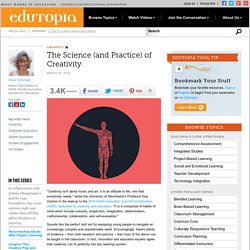
"It is a composite of habits of mind which include curiosity, skepticism, imagination, determination, craftsmanship, collaboration, and self-evaluation. " Sounds like the perfect skill set for equipping young people to navigate an increasingly complex and unpredictable world. Yes, You Can Teach and Assess Creativity! A recent blog by Grant Wiggins affirmed what I have long believed about creativity: it is a 21st-century skill we can teach and assess.

Creativity fosters deeper learning, builds confidence and creates a student ready for college and career. However, many teachers don't know how to implement the teaching and assessment of creativity in their classrooms. While we may have the tools to teach and assess content, creativity is another matter, especially if we want to be intentional about teaching it as a 21st-century skill. In a PBL project, some teachers focus on just one skill, while others focus on many.
Here are some strategies educators can use tomorrow to get started teaching and assessing creativity -- just one more highly necessary skill in that 21st-century toolkit. Quality Indicators. 7 Tenets of Creative Thinking. In school, we learn about geniuses and their ideas, but how did they get those ideas?
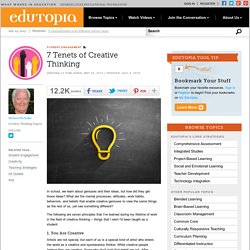
What are the mental processes, attitudes, work habits, behaviors, and beliefs that enable creative geniuses to view the same things as the rest of us, yet see something different? The following are seven principles that I've learned during my lifetime of work in the field of creative thinking -- things that I wish I'd been taught as a student. 1. You Are Creative Artists are not special, but each of us is a special kind of artist who enters the world as a creative and spontaneous thinker. Building Social and Emotional Skills in Elementary Students: The Power of Perspective.
In this nine-part series, we will look at important factors that influence the happiness and social and emotional learning of elementary school age children.
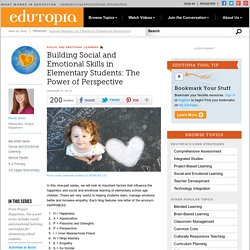
These are very useful in helping students learn, manage emotions better and increase empathy. Each blog features one letter of the acronym HAPPINESS: H = Happiness A = Appreciation P = Passions and Strengths P = Perspective I = Inner Meanie/Inner Friend N = Ninja Mastery E = Empathy S = So Similar S = Share Your Gifts. Perspective: A Game Changer in the Classroom and in Our Lives. What is perspective?
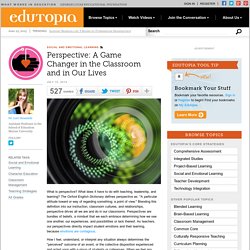
What does it have to do with teaching, leadership, and learning? The Oxford English Dictionary defines perspective as: "A particular attitude toward or way of regarding something; a point of view. " Resilience and Grit Resource Roundup. There’s been a lot of talk lately about resilience, grit, growth mindset, and related concepts -- including the social and emotional skills associated with these factors and their importance for student well-being and academic success.

Edutopia has curated these lists of resources to help educators and parents follow these topics and create home and school environments that provide supports and opportunities to help young people thrive. Nurturing Resilience The ability to bounce back from adversity is associated with a variety of skills. Learn more about the resilience research and supports and strategies to develop resilience in young people. (10+ Resources) Fostering Grit Explore an array of resources about understanding and building student perseverance, and consider questions raised by the research on grit. (15+ Resources) Teaching Growth Mindset Learning From Failure Managing Stress.
Teaching Grit Cultivates Resilience and Perseverance. Five-Minute Film Festival: Videos on Kindness, Empathy, and Connection. Teaching Kindness: More Than a Random Act. It's been a long time since I was in elementary school.
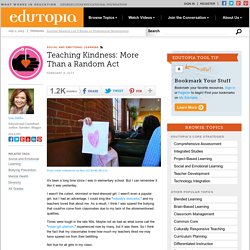
But I can remember it like it was yesterday. I wasn't the cutest, skinniest or best-dressed girl. Why Teaching Kindness in Schools Is Essential to Reduce Bullying. Phrases like "random acts of kindness" and "pay it forward" have become popular terms in modern society.
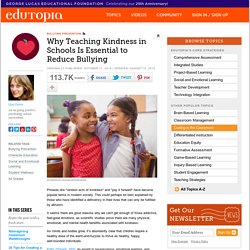
This could perhaps be best explained by those who have identified a deficiency in their lives that can only be fulfilled by altruism. It seems there are good reasons why we can't get enough of those addictive, feel-good emotions, as scientific studies prove there are many physical, emotional, and mental health benefits associated with kindness. As minds and bodies grow, it’s abundantly clear that children require a healthy dose of the warm-and-fuzzies to thrive as healthy, happy, well-rounded individuals. Patty O'Grady, PhD, an expert in neuroscience, emotional learning, and positive psychology, specializes in education. She reports: Kindness changes the brain by the experience of kindness.
A great number of benefits have been reported to support teaching kindness in schools, best summed up by the following. 3 Strategies to Foster Sociability. What helps children engage in learning?
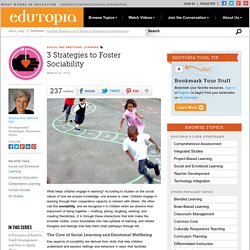
According to studies on the social nature of how we acquire knowledge, one answer is clear: Children engage in learning through their cooperative capacity to interact with others. Social Justice: A Whole-School Approach. Social justice -- what does that mean to you as a person? As an educator? If you're interested in starting this conversation, here's a place to start. At Park Day School in Oakland, California, we use a social justice lens as we design curriculum, organize parent education, and develop school policies to help us better understand and address large, complex social issues such as poverty, food insecurity, racism, and environmental justice. By including our whole community, we create a learning environment that engages teachers, students, families, and staff in a deeper way. The five questions below are designed to help you think about social justice as an educator and inspire conversation. 1. Learning about a social justice issue as a school can help build greater empathy and a deeper understanding across all grade levels.
What is environmental justice? Creating Classrooms for Social Justice. A lot has been discussed and written about being an "educator for social justice. " What does that really mean? In this post, I will break down a few basic classroom practices that allow teachers to engage with best practices in teaching core subjects while also being advocates for social justice in the classroom. Social justice is recognizing and acting upon the power that we have for making positive change. Teachers do this every day in many ways. And, in order to take that idea to the next level, teachers might include classroom practices that will make this dynamic explicit. It is also important to note that many of the practices that demonstrate a social justice orientation are also reflective of best practices in teaching.
Teamwork Rubric. Effective Teams: The Key to Transforming Schools? This fall I've been thinking a lot about what makes a good team in a school context. I'll share some of these thoughts, but I really want to hear your ideas on this subject. I'm going to admit that it's taken me a while to feel convinced by the power of teams. Fair Isn’t Equal: Seven Classroom Tips. In last month's post, I mentioned that there are two skills that separate great teachers from good ones. I explained that the first skill is the ability to reframe student behavior, to see it in new ways. Today I want to discuss the second skill: knowing how to treat students fairly by not treating them the same. Allen Mendler and I introduced the idea that fair isn't equal to the education community in 1988 in the first edition of Discipline With Dignity (an updated, more comprehensive explanation with examples is provided in the current edition). Since then, nearly all of the educators who have used our model have seen remarkable results when resolving a wide range of behavior issues.
The Seven Characteristics of a Good Leader. Updated 01/2014. Gratitude: A Powerful Tool for Your Classroom. Would you like to improve the culture in your classroom and your life? Try gratitude. Based on my ten years of teaching experience, this is the most powerful tool that I know. Habits of Heart: Helping Students Reflect and Act on Gratitude. Gratitude no longer has to be reserved for special occasions and amazing circumstances. Gratitude Can Fuel School Transformation. Building Social and Emotional Skills in Elementary Students: The Power of Appreciation. Cultivating Practical Optimism: A Key to Getting the Best from Your Brain. Editor's note: This post is co-authored by Marcus Conyers who, with Donna Wilson, is co-developer of the M.S. and Ed.S. Brain-Based Teaching degree programs at Nova Southeastern University. Laughter and Learning: Humor Boosts Retention. E.B. Using Humor in the Classroom. “But why do I have to go?
School is not fun!” That quote is from a first-grade child, asking his mom why he has to go every single day to this place that he was told was going to be a lot of fun, but has not lived up to the hype.